
© California Bicycle Coalition 2025

1017 L Street #288
Sacramento, CA 95814
© California Bicycle Coalition 2025
In 2021, CalBike decided to sponsor two related bills that would have legalized walking midblock across an empty street (AB 1238, Ting) or biking carefully through a stop sign at an empty intersection (AB 122, Boerner Horvath). Our goal was to broaden and strengthen the movement for the dignity and safety of people who walk and bike.
Despite the governor’s vetoes (see below), we made significant progress. More than 100 organizations and 3,000 people signed on in support of both bills. Your support made a difference.
The Bicycle Safety Stop Bill received bipartisan supermajority support. The Freedom to Walk Act started a national discussion about how we police walking in this country (covered in the New York Times and on NPR’s “Wait Wait Don’t Tell Me”).
Newsom’s veto messages cited solidarity with our cause, if not our proposals. In his veto of the Freedom to Walk Act, he said, “unequal enforcement of jaywalking laws and the use of minor offenses like it as a pretext to stop people of color … is unacceptable.” His veto of the Bicycle Safety Stop Bill cited his “full support of safe and equitable access to the state’s transportation network for bicyclists.”
Unfortunately, the governor didn’t include specific proposals to accomplish these supposed commitments to our goals in either letter. And we are troubled by his reliance on biased SWITRS data to support conclusions about bicycle and pedestrian safety.
However, CalBike is part of a strong movement and public support for giving people the joyful option to bike safely. It’s affordable, healthy, neighborly, and sustainable. We’ve gained momentum, and we’ll use that to move us forward. CalBike is advocating for significant increases in active transportation investment at the scale needed to make our streets safe for people who bike and walk. We’ll give the governor a real chance to achieve his stated goals, and we’ll build a strong coalition with increasing public support that will make it even harder for lawmakers to reject future proposals.
On October 8, 2021, the governor vetoed two bills that CalBike had sponsored: The Bicycle Safety Stop Bill (AB 122, Boerner Horvath) and the Freedom to Walk Act (AB 1238, Ting). In both cases, he cited data collected by police and, therefore, marred by police biases. In 2021, it should be unacceptable to rely on police accounts when making decisions about public safety. On top of that, Newsom presented slices of data cherry-picked to support his vetoes.
Here’s why Governor Newsom’s statistics, and the conclusions he reached, were misleading, disingenuous, and just plain wrong.
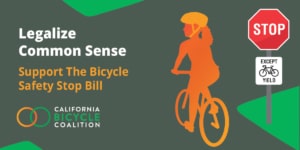
The governor’s veto of the Bicycle Safety Stop demonstrates how inaccurate reporting of bike crashes harms bike safety efforts. The governor cited statistics from the Statewide Integrated Traffic Reporting System (SWITRS), California’s database of crash reports compiled by police departments around the state. It is the only official source of data about the cause of traffic crashes.
In his veto message, Newsom’s claim that 88% of the people killed while biking past a stop sign were at fault displays a fundamental failure to understand safe bicycling or account for the anti-bike bias that is endemic to policing. And, unfortunately, police have only the car driver’s word for what happened after they have killed someone on a bike.
For example, when Amelie le Moullac was killed in San Francisco by a truck turning right into her path, the police report faulted the bicyclist for running into the side of the truck. SFPD didn’t even bother to look for evidence to back up this anti-bike assumption. It was the San Francisco Bicycle Coalition that found camera footage of the crash, proving that Ms. le Moullac was standing legally in the bike lane when the truck turned into her.
According to SWITRS, people on bikes and walking are constantly throwing themselves in front of law-abiding drivers and suffering death and injury as a result.
SWITRS data is unreliable. Police aren’t trained in the choices people on bikes make to ensure their safety, and they then make assumptions about who is at fault in a crash based on preconceived ideas about bicyclists’ bad behavior. Unfortunately, this unverified information influences policy debates throughout California. When the media reports on a controversial bike safety improvement, reporters cite SWITRS that claims half of all bike crashes are the bicyclist’s fault. That false statistic reduces the political will to take the actions needed to truly make the streets safe for people on bikes.
In his veto statement for the Freedom to Walk Act, the governor used CHP talking points to blur the truth about what really makes pedestrians most vulnerable: prioritizing fast-moving cars and trucks over human life. People walking don’t stand a chance when two tons of steel take ownership of public streets, and crashes are considered the collateral damage of modern life.
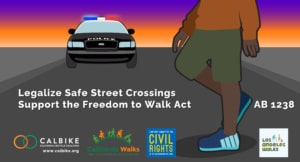
The biggest problem with Newsom’s cherry-picked SWITRS data is that he didn’t include ALL pedestrian crashes. He just cited fatalities, but fatal crashes represent only a small share of the accidents where cars hit pedestrians, and using this figure gives a distorted picture of street safety.
When you look at all crashes involving a car and a pedestrian, it becomes clear that it’s not those crossing outside of crosswalks that are at most danger. California’s own data show that 44% of all pedestrian crashes occur when someone is “crossing at a crosswalk in an intersection.” Almost 70% of collisions involving pedestrians are caused by the driver disregarding a traffic law.
In addition, SWITRS data is drawn from accident reports prepared by the police, who have a notoriously anti-pedestrian bias. It’s not surprising that police would find pedestrians at fault for “taking actions against traffic controls or safety laws” in 63% of fatal crashes. Police, and our society at large, don’t place enough responsibility on car drivers to share the road responsibly with other road users.
When did the penalty for walking outside of proscribed pedestrian boundaries become a death sentence?
It is inaccurate for the governor, using arguments from the CHP, to insinuate that illegal crossings are the reason for rising pedestrian fatality rates. There’s no evidence of a rise in jaywalking correlated with an increase in pedestrian fatalities. In fact, recent data from the state of Virginia shows the opposite. After the state decriminalized jaywalking earlier this year, initial data indicates that it hasn’t made pedestrians less safe.
But there is a correlation that increased distracted driving and a trend toward higher front grills, mainly on trucks and SUVs, which reduce visibility for drivers and increase the deadliness of car-pedestrian crashes that correlates with this increase.
Also, it is not surprising that the most deadly crashes happen outside of crosswalks, where drivers travel at much higher speeds.
The prevalence of faulty data in these reports is also an argument for reducing the police role in traffic crash reporting. The movement to refocus police energy away from such activities is growing. For instance, the City of Berkeley is considering transferring that duty to its Transportation Department to allow police officers to focus more on crimes they are better equipped to deal with, an initiative that CalBike supports.
Fact-checking SWITRS accident reports would go a long way toward changing the narrative about who causes the most harm on our street. But it will be a big job to comb through the data, investigate the facts, and prepare more truthful reports. Still, it’s a critical job. If you know someone willing to analyze the SWITRS data and provide more accurate accident data, contact Jared Sanchez at jared@calbike.org.
For Immediate Release: October 11, 2021
Contact:
CalBike: Jared Sanchez, jared@calbike.org | 714-262-0921
California Walks: Caro Jauregui, caro@calwalks.org | 562-320-2139
Los Angeles Walks: John Yi, john@losangeleswalks.org | 213-219-2483
SACRAMENTO – In a setback for the movement for more equitable streets, Governor Gavin Newsom vetoed the Freedom to Walk Act (AB 1238, Ting). The law would have ended penalties for safe mid-block pedestrian crossings. CalBike and a coalition of more than 90 groups and individuals supported the repeal of ‘jaywalking’ laws.
“The governor’s veto rests on the belief that police enforcement or the threat of jaywalking tickets will somehow prevent pedestrian fatalities in the future when that has consistently failed in the past. Continuing to criminalize people’s rational, predictable responses to poor infrastructure is simply unjust,” said Jared Sanchez, CalBike Senior Policy Advocate.
Inequities in neighborhood design and street infrastructure leave many lower-income California neighborhoods less than pedestrian-friendly. Because of this, policing jaywalking often amounts to punishing people for the lack of government services in their community.
Legalizing mid-block crossings would have helped protect vulnerable pedestrians against racially biased, pretextual policing, inequitable fees and fines, and unnecessary and potentially lethal interactions with law enforcement.
John Yi, Executive Director of Los Angeles Walks, said, “The Governor’s recent veto represents continued condescension of pedestrians. To think we can penalize our parents, seniors, and students to bow to high-speed traffic at the cost of their own dignity, ease, and safety is draconian and deeply misunderstands the needs of those walking every day. We cannot begin to ask why it is we jaywalk if we are already criminals in the eyes of the state.”
“This is a tremendous loss not only for racial justice across California but also for active transportation as a whole as Governor Newsom failed to recognize the importance of non-automobile modes of travel,” said CalBike’s Sanchez. “But the Freedom to Walk Act has helped spark a national conversation about unjust jaywalking laws that can’t be stopped by one misguided veto.”
###
It was the middle of the afternoon in Culver City when Richard Milton left his optometrist to reach the bus stop across the street. “It was in the middle of the block,” he recalled. “There wasn’t any traffic, so I crossed.”
As he walked toward the bus stop, a police car pulled up, and an officer asked Milton, a 66-year-old Black Army veteran, where he was going. Milton said he was headed for the bus stop. The officer wrote him a ticket for jaywalking.
“I just remained mute as he wrote me the ticket,” he said.
“Jaywalking” was invented by auto clubs and car manufacturers 100 years ago. At that time, ‘jay’ was an offensive term to describe an unsophisticated country person.
If someone invented the term today, we might call it “redneck crossings” or “hickwalking.” If those terms sound shocking and rude, that’s the point. We’ve gotten used to the word jaywalking, but we should remember that automakers used prejudice and stigma to enforce a street culture that favored driving over walking. Over time, ‘jaywalking’ has also come to carry racist undertones, as enforcement focuses mainly on policing the movements of Black Americans.
“In the early days of the automobile, it was drivers’ job to avoid you, not your job to avoid them,” says Peter Norton, a historian at the University of Virginia and author of Fighting Traffic: The Dawn of the Motor Age in the American City. “But under the new model, streets became a place for cars — and as a pedestrian, it’s your fault if you get hit.”
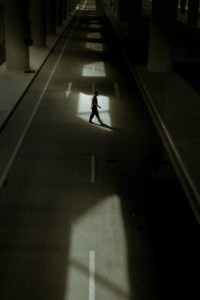
Richard Milton’s race was likely a factor in his traffic stop for jaywalking. CalBike’s data review shows that Black Californians are as much as 4.3 times as likely to get stopped for jaywalking than white residents.
A recent lawsuit filed for bias against Black people on Rodeo Drive underscores that point. The suit (plaintiffs’ attorneys include Benjamin Crump, who represented George Floyd’s family) alleges that, out of 106 people arrested by a Beverly Hills Police task force in the area, 105 were Black, and one was Latino and appeared Black. Those figures don’t include people stopped and hassled by the police, though there is a video of at least one Black man (a VP at Versace) being stopped and frisked as he left the Rodeo Drive store.
Jaywalking tickets also have unequal impacts. Milton’s citation was for more than $190, which was money he didn’t have. He was fortunate to have access to a program out of Venice that provides volunteer attorneys to represent people who are issued citations. His attorney discovered that the officer had written the wrong code on the citation and had the ticket voided.
Even if he hadn’t had access to an attorney, Milton would have gone to court to fight the ticket because unpaid tickets can keep you from renewing your driver’s license and cause other problems. “It’s a nuisance to have it hanging over your head,” he said.
When asked if his run-in with the police has changed his behavior around jaywalking, Milton said, “I still jaywalk.”
“In LA, intersections are bad. They are very bad,” he added. “You see cars coming at you, even though you have the green light.” Then he repeated “It’s not safe,” several times for emphasis.
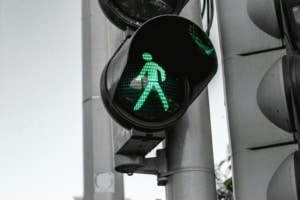
In fact, the midblock crossing wasn’t simply the most convenient way to get across the street for Richard Milton. It was a conscious choice for his safety, based on his own harrowing experience.
He knows what he’s talking about. He has been hit by a car twice while walking, both times in the crosswalk. He was fortunate to have suffered only minor injuries, but he has friends who have been seriously injured in crosswalks.
Milton’s concern is backed by statistics. CalBike’s analysis of SWITRS collision data found that 44% of pedestrian collisions in California occurred at intersections. Another study found that, while a quarter of pedestrian injures happen during mid-block crossings, 75% occur elsewhere, including intersections (26%), sidewalks, and the margins of roadways without sidewalks.
Milton doesn’t see the sense of penalizing somebody for choosing the safest way to cross the street based on their experience. If someone made it to the other side of the road and didn’t cause any harm, he said, “Why criminalize them?”
California was at the forefront of the car-centric movement to chase people on foot out of the roadway. As a recent LAist article noted, LA passed its first jaywalking law in 1925. LA’s laws became a model for the rest of the country. Now, California has the opportunity to lead in the other direction toward a more pedestrian-friendly future.
Already this year, Virginia made jaywalking a secondary offense. It’s still a crime, but an officer can’t initiate a stop because of jaywalking and can’t issue a citation unless they stop you for something else. But the Freedom to Walk Act (AB 1238, Ting) would go a step further in the right direction. It would make safe mid-block crossings legal.
Today, the only thing that stands between California and the freedom to walk is the governor’s signature. If Governor Newsom signs AB 1238, it will still be against the law to disrupt traffic, but people who safely cross, like Richard Milton, will no longer get stopped, questioned, and ticketed by the police. Tell the Governor you support the Freedom to Walk Act, AB 1238.
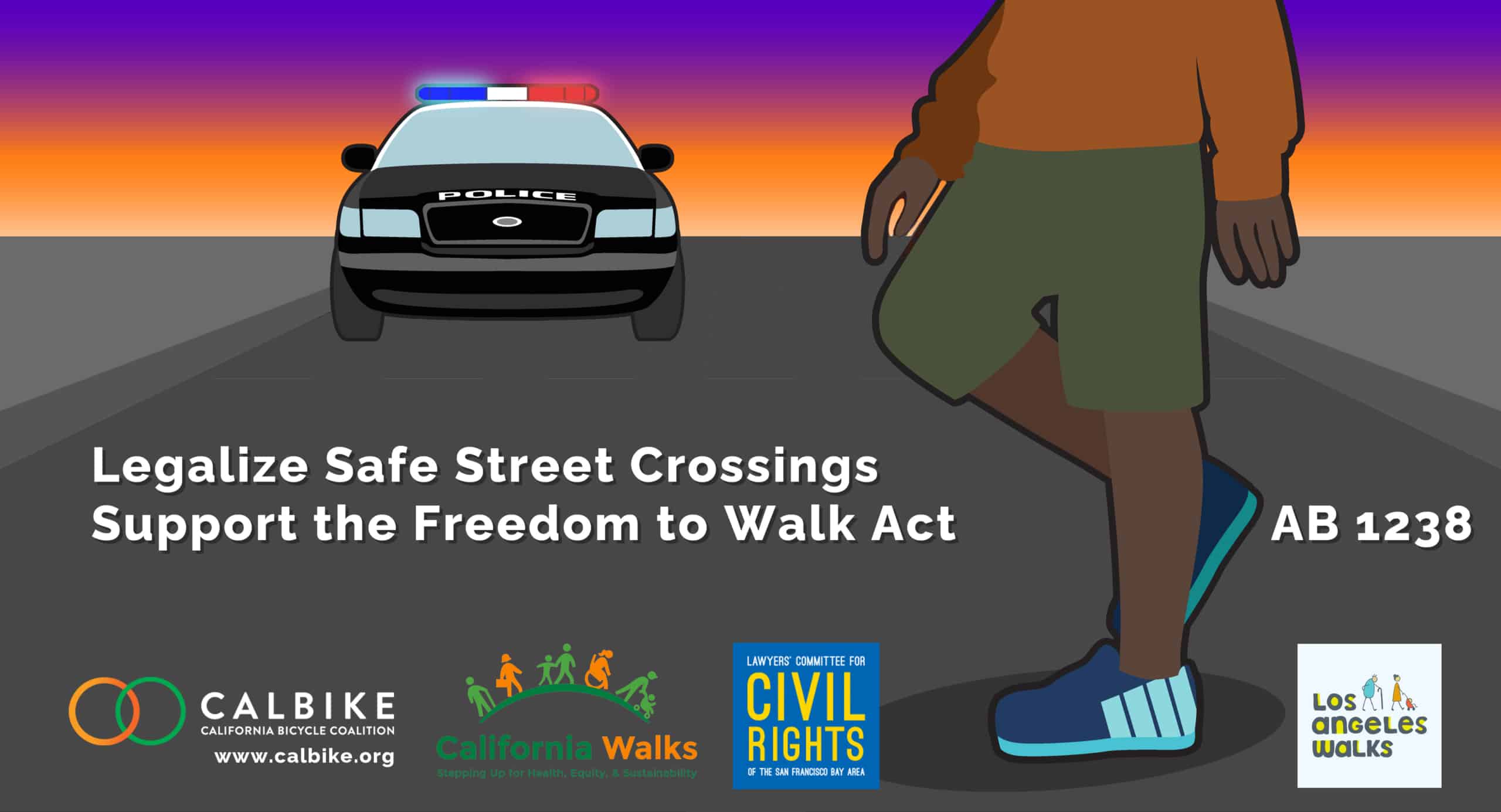
The Freedom to Walk Act passed out of the California Senate Appropriations Committee on Thursday. We’re thrilled lawmakers agreed that, as a state, we should stop raising revenue from our most marginalized and vulnerable residents.
There are two more crucial steps before we repeal unjust jaywalking laws, and we’ll need your help to get there.
First, the Freedom to Walk Act will need a majority vote on the Senate Floor in the next few weeks. The bill needs 21 votes to pass. Please email your California Senator today and ask them to vote YES to legalize safe walking.
Second, the bill needs Governor Newsom’s signature. If/when it passes the Senate, we’ll need help to let the governor know that Californians support ending unjust jaywalking laws.
Nationally, pedestrian traffic deaths grew by 46% from 2010 to 2019, a much larger increase than all other vehicle-caused fatalities. The effects have fallen disproportionately on Black Americans, who now suffer a higher rate of pedestrian fatalities than other ethnic groups. It makes sense to be concerned about pedestrian safety and to hesitate to make any change that will make pedestrians more vulnerable.
However, there’s no reason to believe that jaywalking laws are preventing additional pedestrian deaths. Bloomberg CityLab reported that only 26% of severe pedestrian injuries occur during mid-block crossings. Another 25% of collisions involving pedestrians happen in crosswalks. And fully 50% of serious pedestrian crash injuries happen in other locations, including cars running up on the sidewalk and people hit while tending to their car by the side of the road.
“New data from the Governors Highway Safety Association (GHSA) projects that 2020 had the largest ever annual increase in the rate at which drivers struck and killed people on foot. What drove this surge? The likely culprits are dangerous driving like speeding, drunk and drugged driving, and distraction, which were rampant on U.S. roads during the COVID-19 pandemic, combined with infrastructure issues that have prioritized the movement of motor vehicles over walking and bicycling for many years.”
May 20, 2021, press release from the GHSA
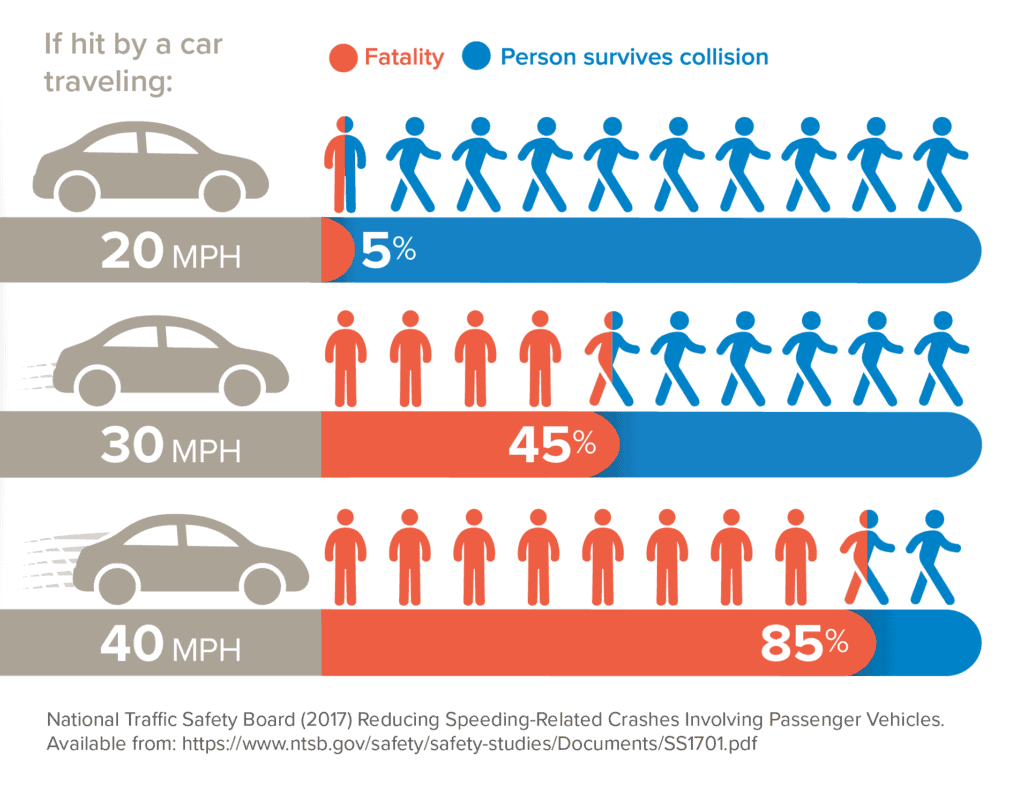
Pedestrians, like most road users, use self-interest to guide their actions. After all, running out into the street could have lethal consequences for someone on foot. And, while young children aren’t always capable of making good decisions about street crossings, what keeps them safe is parental supervision, not jaywalking laws.
Rising pedestrian injuries and fatalities are a legitimate concern that policymakers should address. But jaywalking laws aren’t the solution. California has enforced the existing jaywalking laws for the past 10 years while pedestrian fatalities soared. To protect people who walk, we must look at the true causes of the rising toll on pedestrians.
For example, it’s no accident that the upward trend in pedestrian deaths has matched the increase in popularity of SUVs. Higher front grills make them more lethal to people on foot, and increasingly tall front ends create large front blind spots. Testing and rating the crash safety of cars for people outside the vehicle as well as inside would be an excellent first step towards increasing pedestrian safety.
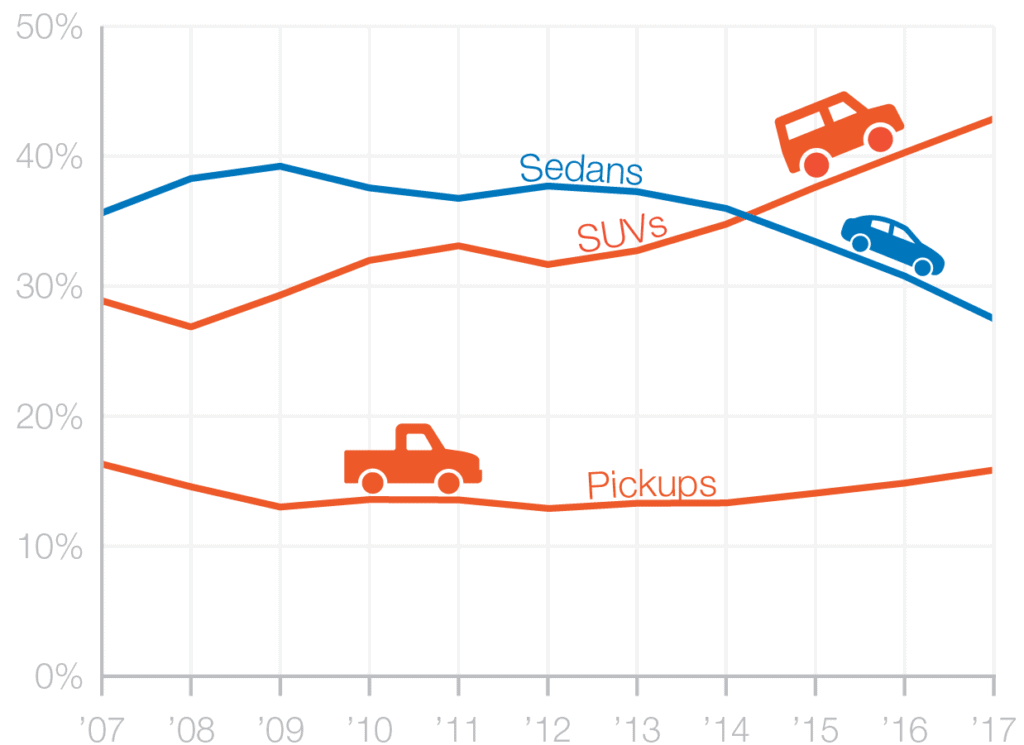
In addition, as the GHSA noted, our built environment has for years prioritized the movement of motorized vehicles over the safety of people on foot and on bikes. Making pedestrian safety paramount in street repaving projects will do more to prevent pedestrian deaths than criminalizing walking on poorly-designed streets where jaywalking is sometimes the safest option.
It’s critical to look at who stands on both sides of this issue. Local police departments and the CHP have exerted pressure against AB 1238. They witness the worst-case scenarios and that, along with the idea that enforcement and punishment keep people safe, shapes their view of jaywalking.
Police see the pedestrian under the influence who stepped into a busy street and got hit. They don’t see the much more common crossings that people make in every California community every day: people walking safely, taking the most logical routes to their destinations, often using a mid-block crossing to get where they need to go.
Jaywalking laws can’t prevent the tragedy of an impaired person making an unsafe crossing. And they don’t stop careless drivers from hitting pedestrians in crosswalks and on sidewalks, which is where two-thirds of accidents that involve pedestrians take place, according to our analysis of SWITRS crash data. In almost all of those collisions, the car driver is at fault.
Our lawmakers should listen to the voices of the people who walk every day and their advocates. They should listen to over 100 organizations that signed on in support of the Freedom to Walk Act, to the supporters of racial justice who understand that jaywalking laws have been and will continue to be a significant pretext for biased policing.
Police will claim that jaywalking laws cause people to walk in predictable patterns, which allows all users to share the road more safely. However, since the driver is at fault in most pedestrian fatalities, the safety conversation should focus on the behavior of car drivers, not people on foot.
Enforcement of jaywalking laws doesn’t deter mid-block crossings, but it does reinforce privilege because poor and Black people are much more likely to get ticketed and harassed.
Here’s a thought experiment: notice where you walk over the next few days. Do you always find a crosswalk or, when there’s no traffic, do you sometimes cross mid-block? Everybody jaywalks — and that probably includes you.
CHP officers and local police witness firsthand the horrific results when a car hits a pedestrian at speed. Naturally, they want California laws to prevent as many devastating collisions as possible, so we can understand why some police organizations don’t want to see the Freedom to Walk Act become law.
However, if police, policymakers, and elected officials want to protect pedestrians from harm, there are much better ways to do that than jaywalking tickets. For example, they could support AB 43, which gives communities more options to lower speed limits. Reducing speed is one of the best ways to save lives: at 20 mph, a pedestrian has a 95% chance of surviving being hit by a car. At 40 mph, the survival rate is just 15%.
AB 1147 is another terrific pedestrian safety measure. The bill would change how planners write regional transportation plans, prioritizing alternative transportation options, including walking and biking. A 15-minute neighborhood is a community that gives people ways to walk safely to their local destinations.
For more reasons to legalize safe street crossings, we’ve got answers to your questions about the Freedom to Walk Act.
For Immediate Release: 8/27/21
Contact:
CalBike: Jared Sanchez, jared@calbike.org | 714-262-0921
California Walks: Caro Jauregui, caro@calwalks.org | 562-320-2139
Los Angeles Walks: John Yi, john@losangeleswalks.org | 213-219-2483
SACRAMENTO – The Freedom to Walk Act, a bill designed to reform California’s “Jaywalking” laws, passed out of the California Senate Appropriations Committee on Thursday, on a 5-2 vote.
The bill AB 1238, would make it legal for pedestrians in California to cross mid-block provided they don’t interfere with traffic. The bill was authored by Assemblymember Phil Ting of San Francisco. CalBike and a coalition of more than 85 groups and individuals support the repeal of jaywalking laws.
Jared Sanchez, CalBike Senior Policy Advocate said, “The State Senate and Governor now have a chance to advance racial justice by repealing jaywalking laws. In the absence of safe and accessible pedestrian infrastructure, residents do their best to access school, work, grocery stores, or parks. At times, this may involve jaywalking. Continuing to criminalize rational, predictable responses to poor infrastructure is unjust.”
The Bill would not change existing law that already requires pedestrians to avoid potentially hazardous situations on the roadway. Instead, it will protect vulnerable pedestrians against racially biased, pretextual policing; inequitable fees and fines; unnecessary, and potentially lethal, interactions with law enforcement.
By decriminalizing safe-street crossings, the bill will reduce unnecessary police enforcement of jaywalking. Enforcing low-level infractions, like jaywalking, can have a substantial cost for law enforcement. Given this, decriminalizing safe street crossings has the potential to conserve substantial resources for agencies across the state.
Inequities in neighborhood design leave lower-income neighborhoods less pedestrian-friendly than others. Because of this, policing jaywalking often amounts to punishing people for the lack of government services and improper land use planning in their community. People should not be penalized for decades of infrastructure neglect and auto-first street design.
There is no evidence that jaywalking laws keep people safe. In fact, we know that these laws make many Californians unsafe by exposing them to pretextual policing and unnecessary encounters with law enforcement. California is in the process of reforming its laws regarding the use of public spaces. Several categories of infractions have already been eliminated in recent years at the state level, including vending without a permit and possession of marijuana. It’s time to add jaywalking to this list.
For Immediate Release: June 25, 2012
Contact:
CalBike: Jared Sanchez, jared@calbike.org | 714-262-0921
California Walks: Caro Jauregui, caro@calwalks.org | 562-320-2139
Los Angeles Walks: John Yi, john@losangeleswalks.org | 213-219-2483
SACRAMENTO – The Freedom to Walk Act, a bill to eliminate jaywalking laws in California, will be heard on Tuesday, 6/29/21 in the California Senate Transportation Committee.
AB 1238 will make it legal for pedestrians in California to cross mid-block and against traffic lights, provided they don’t interfere with traffic. The bill is authored by Assemblymember Phil Ting of San Francisco. CalBike and a coalition of more than 85 groups and individuals support the repeal of jaywalking laws.
“The incredible rate at which pedestrians are dying from crashes should compel us to understand why fellow Californians navigate as such, not criminalize them. This is just the first of many steps in our fight to provide all those who walk and roll with a little more dignity,” shared John Yi, Executive Director of Los Angeles Walks.
Jared Sanchez, CalBike Senior Policy Advocate said, “Jaywalking citations are disproportionately issued to Black Californians – they are up to 4.3 times more likely to be stopped than their White counterparts. Decriminalizing jaywalking will remove an opportunity for biased policing, and get rid of an unjust burden on low-income California residents, who can least afford to pay the fines and who are more likely to live in neighborhoods that lack infrastructure for people who walk, making jaywalking unavoidable.”
“Creating safe public spaces by changing policies that have disregarded the safety, existence, and joy of primarily low-income people of color across the state is overdue. This bill will begin to do that by ensuring that people forced to ‘jaywalk’ are not punished due to the decades of intentional poor infrastructure in their neighborhoods,” said Caro Jauregui, Co-Executive Director of California Walks.
CalBike, California Walks, Los Angeles Walks, and the Lawyers’ Committee for Civil Rights of the San Francisco Bay Area are sponsoring the Freedom to Walk Act, which has strong support from a broad base of community organizations. Supporters include the California Pan-Ethnic Health Network, Community Legal Services of East Palo Alto, Asian Pacific Islander Forward Movement, and Communities United for Restorative Youth Justice. Several city officials have expressed their support for decriminalizing jaywalking, including the Emeryville City Council.
AB1238 was passed by the California State Assembly with a floor vote of 58-16 on June 2, 2021.
On May 3, 2021, CalBike co-hosted a national panel discussion on decriminalizing jaywalking. Leading academics, advocates, and legislators discussed local efforts to end the enforcement of jaywalking. They shared lessons learned and steps to success.
CalBike has joined a surging national movement to repeal unjust jaywalking laws by co-sponsoring the Freedom to Walk Act (AB 1238, Ting). More and more cities and states are rethinking rules that criminalize walking. From Virginia to California to Kansas City, decriminalizing jaywalking is no longer a radical idea but an increasingly viable policy proposal.
The discussion included:
You can watch the full presentation here:
These national efforts highlight the need to protect vulnerable pedestrians against racially biased, pretextual policing, inequitable fees and fines, and unnecessary and potentially lethal interactions with law enforcement. More and more cities, counties, and states are considering repealing jaywalking laws. And the movement to ensure that safe and accessible walking is a key component of a sustainable transportation system continues to grow stronger.
Since our national discussion, Kansas City, MO, became the first city in the country to repeal its jaywalking laws. This repeal followed strong efforts from BikeWalkKC. We hope that CalBike’s campaign will make California the first state to decriminalize jaywalking statewide.
Eliminating jaywalking laws is an important step towards a more just society. Protests following George Floyd’s murder by a police officer led to a movement to re-examine the role of policing in our communities. As part of this reflection, jurisdictions began to look at discriminatory enforcement of jaywalking laws. Examination of jaywalking citations in Kansas City clearly showed that Black pedestrians were disproportionately targeted. The City Council’s repeal removes a tool for biased policing.
CalBike is committed to reforming traffic laws to reduce inequities and racially biased policing. Eliminating laws against jaywalking is an essential step toward this goal. By co-sponsoring the Freedom to Walk Act, we hope to end the enforcement of unjust jaywalking laws in California. At the same time, this will facilitate healthy and safe travel modes that are necessary to meet California’s environmental goals.
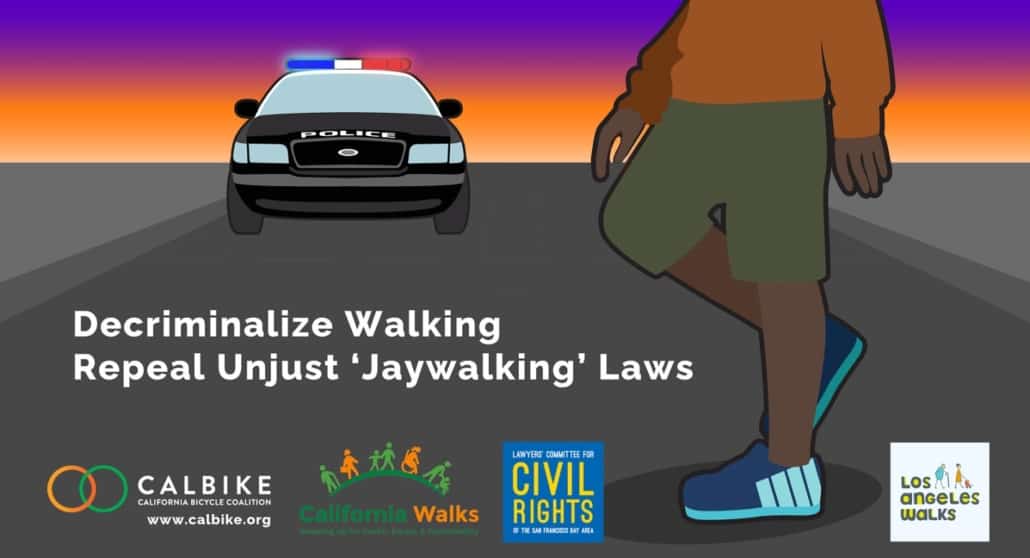

© California Bicycle Coalition 2025

1017 L Street #288
Sacramento, CA 95814
© California Bicycle Coalition 2025
